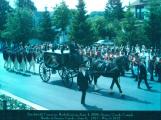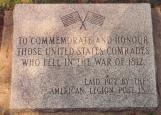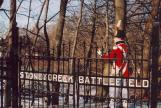1
The Battlefield Cemetery at Smith's Knoll is located across the street from Battlefield House. On this prominent hill on June 5, 1813, American forces set up camp and artillery to guard against a possible attack from the British.3
In 1889, the Wentworth Pioneer Historical Society was formed. This group of men set out early initiatives to erect a monument commemorating the Battle of Stoney Creek. In the Parliamentary session of 1894, an appropriation was made for monuments at several historical sites (Stoney Creek included).The Society desperately wanted to build a monument, but determining the site for one would prove difficult. The Society began studying accounts and localities associated with the Battle. Some significant sites included the Gage Homestead (and surrounding area)and Burlington Heights. Historical documents were studied and inquiries were made to people who remembered the Battle.
In 1894, George Fisher offered, at a sale price of $1900, the Gage Homestead and four acres of surrounding land. Sara Calder, granddaughter of James and Mary Gage and member of the Ladies' Auxiliary for the Society, strongly supported this offer, despite its high cost. The men paid little attention to Fisher's offer and Sara Calder condemned the men for making what she saw as the wrong decision. A second site was also offered; a plot of land 42 by 60 feet located at Smith's Knoll on the north side of the road for $50.
Great efforts were made by the men of the Society to promote Smith's Knoll as the "historically accurate" choice for a commemorative monument. These arguments included the fact that the Americans placed artillery on the Knoll, which was subsequently captured by General Plenderleath and his 30 men. Also, in 1889 and in 1998, soldier's remains, including bones, pieces of fiber and buttons, were unearthed at the Knoll.
Fundraising and Government support for a monument at Smith's Knoll were the two major obstacles the men had to face. Sara Calder and the Women's Wentworth Historical Society had much to do with the delay in having this monument built.
Finally, on January 13, 1909, The Women's Wentworth Historical Society, the Wentworth Historical Society and the County of Wentworth Veteran's Association agreed to join in raising $1500 to erect a monument on Smith's Knoll. After the Smith's Knoll monument was constructed the government grant of $5000 would be allocated to the Women's Wentworth Historical Society to erect a monument in Battlefield Park.
On Monday, August 1st, 1910, a ceremony was held to unveil the monument at Smith's Knoll.
4
The stone cairn, built from local stone, at Smith's Knoll, prior to the addition of the lion statue.1909
Smith's Knoll
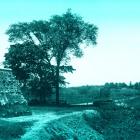
5
In 1889, seventy-six years after the battle, Allen Smith, was ploughing (sic) his father's farm, when he uncovered human bones and bits of cloth with the insignia of both British and American regiments. The discovery led to more intensive digging and soon, the bodies of 23 unknown soldiers were found. This area was known as Smith's Knoll and it was here where the American guns had been placed during the battle. In 1910, a cairn was erected at Smith's Knoll, to mark the last resting place of soldiers who had engaged in such a short but violent battle. Stones and boulders were gathered from nearby fields and red clay from the district was used to mark the crosses in the Union Jack. The Lion, on guard, atop the cairn, was made of stone.On June 6, 1926, the National Society of United States Daughters of 1812, presented a bronze tablet in honour of the unknown Americans who had died on "foreign soil". They also presented an American flag with the words "I hope that Old Glory will ever float side by side with the Union Jack, carrying with it the message as it has done for over one hundred years, that of good will and harmony."
6
A skull uncovered during the archaeological excavation of the Battlefield Cemetery at Smith's Knoll.1999
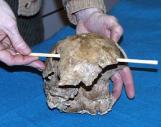
7
By July 1998, Smith's Knoll was in need of repairs. There was public interest in making the Knoll more inviting. This included wheelchair accessibility, better lighting and a repositioning of the stone wall. Before any of these changes could be made, an archaeological investigation was conducted. During the excavation, military buttons and human remains were found. By the summer of 1999, the dig was complete and renovations commenced. A re-dedication and re-interment ceremony was held on June 4, 2000.9
In late spring of 2000, the restoration and excavation efforts were complete.On June 4th, 2000, a Rededication ceremony took place, with hundreds of spectators and the participation of re-enactors and military personel from Canada and the United States.
The American participants included Military Pallbearers from the 3rd United States Infantry from Fort Meyer, Virginia, who accompanied the 19th century glass hearse on its procession to Smith's Knoll.
Representatives from the current Regiments who fought in the Battle of Stoney Creek included the First Battalion of the King's Regiment and the Royal Gloucestershire, Berkshire and Wiltshire Regiment.
The Rededication ceremony officially re-opened the Battlefield Cemetery and marked the re-interment of the remains of the soldiers who died in battle with full international military honours.
11
The inscription on the gravestone for the American soldiers at the Knoll reads,To Commemorate and Honour those
United States Comrades who fell in
The War of 1812
The inscription on the Smith's Knoll cairn reads,
The Battle field Cemetery
6th June 1813
in memory of 20 good and true King's men who
in fighting in defense of their Country, died and
were buried on this Knoll

